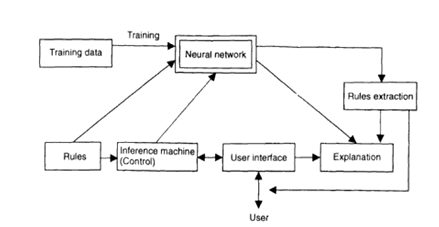SKEDSOFT
Introduction:-Connectionist expert systems are expert systems which have their knowledge base represented in a connectionist structure. The neural network properties of learning and generalization, adaptability, robustness, associative storage of information, massive parallelism, and other characteristics make them a very powerful paradigm for building knowledge based expert systems.
 A general architecture of a connectionist expert system (CES):-It is distinguished from the symbolic AI and fuzzy expert systems in the way problem knowledge is used. Here problem knowledge need not only be a set of heuristic rules but can also be given as a set of past experience examples, for example, case studies of how a physician has previously treated patients. A CES may contain the following modules:
A general architecture of a connectionist expert system (CES):-It is distinguished from the symbolic AI and fuzzy expert systems in the way problem knowledge is used. Here problem knowledge need not only be a set of heuristic rules but can also be given as a set of past experience examples, for example, case studies of how a physician has previously treated patients. A CES may contain the following modules:
A connectionist knowledge-based module, represented as connectionist architecture. Four different approaches to its building are:-
1. Past, historical data are used to train a network. After training, the network contains the system's knowledge.
2. Existing problem knowledge, for example, rules, is implemented in a neural network. One way to do this is to represent the rules in the form of a set of training examples and train a neural network with these examples using standard training algorithms, as presented in chapter 4. The rules are considered as input-output associations to be learned by a neural network.
3. Existing problem knowledge, for example, rules, is used to prewire (to calculate the connection weights) a network structure instead of training it. This is the case of inserting explicit knowledge in a neural network structure.
4. All of the above methods are used for building the system. For example, the neural network isprewired according to an existing (initial) set of rules and then trained with data either past data orcurrent data accumulated when the system is running.
Apart from the above approaches it is possible to combine knowledge represented in a symbolic or fuzzy form with knowledge represented in a connectionist form.
-
A connectionist inference control module, which controls the information flow between all the modules and initiates inference over the connectionist knowledge base. A connectionist inference is characterized by some desirable features, one of them being approximate reasoning, that is, if the new input data do not match exactly the previous examples or the conditions in the problem knowledge rules, a solution close to an optimal one is found. Approximate reasoning in connectionist systems is possible because of their faculty for generalization.
-
Rules extraction module, which analyzes the connectionist knowledge base and produces theunderlying rules that are inherent, or ''buried," in the data.
- User interface module, which "communicates" with the user or with the environment. As a userinterface, a spoken or natural language interface can be used, developed on the basis of using neuralnetworks or other techniques.